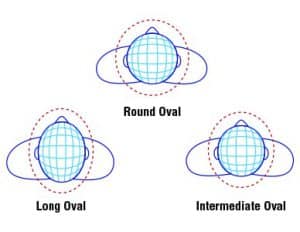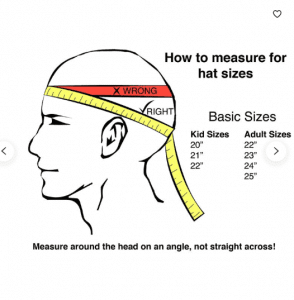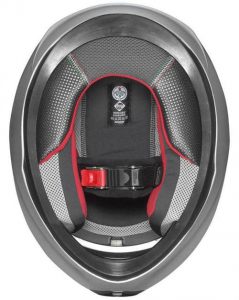The importance of wearing a properly fitting motorcycle helmet cannot be overstated. According to the World Health Organization (WHO), road traffic injuries are a leading global cause of death and disability, with head and neck injuries being the primary contributors to fatal and severe outcomes in motorcycle accidents.
And motorcycle helmets are designed to absorb impact and reduce the risk of severe head and brain injuries by 63%-88%. But to function effectively, a helmet must fit properly. Besides, an ill-fitting helmet can cause discomfort and lead to distractions while riding, compromising safety.
| Helmet Name | Category | Shell Sizes | Check & Shop Now |
|---|---|---|---|
| AGV K1 | Best Overall | 2: XS-MS, ML-XXL | RevZilla | MotoSport | J&P Cycles |
| Scorpion EXO R420 | Most Versatile | 2: XS-MD, LG-3XL | RevZilla | MotoSport | Amazon |
| Bell Qualifier DLX | Best Street | 3: XS/S, M/L, XL/2XL | RevZilla | BTO Sports | Amazon |
| HJC i10 | Best Budget-Friendly | 3: XS/S, M/L, XL/XXL | RevZilla | MotoSport | Amazon |
| LS2 Rebellion | Best Classic | 2: XS-LG, XL-2XL | RevZilla | BTO Sports | Amazon |
How to Properly Fit a Motorcycle Helmet: A Step-by-Step Guide
To ensure both safety and comfort, follow these seven steps to properly fit your motorcycle helmet:
- Measure Your Head: Use a soft measuring tape to measure the circumference of your head approximately 1 inch above your eyebrows.
- Select the Right Size: Choose a helmet size based on your measurement and refer to the manufacturer’s sizing chart.
- Check the Fit: Place the helmet on your head. It should fit snugly without causing discomfort and should not shift or move when you shake your head.
- Adjust the Chin Strap: Fasten the chin strap so it fits comfortably under your chin, with no more than two fingers’ width between the strap and your skin.
- Verify the Helmet Position: Ensure the helmet sits level on your head, covering your forehead without obstructing your vision.
- Test the Fit: Grip the chin bar and move the helmet. Your cheeks should move with the helmet, not the helmet itself. If the helmet shifts, try a smaller size.
- Allow for Break-In: Keep in mind that helmet liners typically break in by 15-20% after 15-20 hours of use, so a helmet that feels slightly tight may become more comfortable over time.
Remember, all these steps start with selecting a helmet that meets mandatory safety standards.
Motorcycle Helmet Safety Standards and Ratings
Proper helmet fit is crucial for ensuring that safety standards such as DOT, SNELL, FIM, SHARP, and ECE are met. These standards are tested using at least two outer shell sizes, with each size subjected to the same rigorous evaluations. Helmets meeting these standards will display stickers indicating their certification type.
- DOT: The DOT standard is the minimum safety requirement set by the U.S. Department of Transportation (federal standard FMVSS 218). The standard outlines the basic performance levels a helmet must achieve to protect the head and brain in the event of an accident. Helmets sold in the U.S. must meet these criteria.
- ECE: The ECE standard, specifically ECE 22.06, is determined by the Economic Commission for Europe. It is a basic certification standard widely recognized in Europe and many other countries.
- SNELL: The SNELL M2020 standard, developed by the Snell Foundation, is considered the gold standard for helmet safety in the U.S. The Snell Foundation, established in 1957 in memory of race car driver William “Pete” Snell, focuses on research, testing, and developing helmet safety standards. Helmets certified to meet this standard are often more expensive than those meeting only DOT or ECE standards.
- FIM: The FIM standard is used by the global motorcycle racing organization to certify helmets for track use. This certification ensures that helmets meet the rigorous demands of professional motorcycle racing, offering the highest level of protection on the track.
- SHARP: The SHARP (Safety Helmet Assessment and Rating Programme) standard is based on extensive testing designed around European-specific data. While SHARP provides valuable information on helmet safety performance, it does not include data related to U.S. riding conditions.
These standards ensure that helmets offer the necessary protection, but the fit remains a key factor in safety.
How to Select and Fit a Motorcycle Helmet
The importance of a properly fitting helmet cannot be emphasized enough. Regardless of the type of safety certification rating a helmet has been issued, the rating is applied to the helmet based on the helmet fitting properly and doesn’t apply to one that is either too big or loose-fitting or to one that fits too tightly.
And, because as unique individuals, we have different head shapes and sizes, there are a few steps that need to be taken to find a helmet that will provide a proper fit for your specific head shape and size. Before starting your search for a helmet, you should learn what your personal head shape and size are as all helmet models and styles may not be available in the size you need.
Head and Helmet Shape
The first step in finding a helmet that fits is to determine the general shape of your head. There are three primary head shape categories that people’s heads generally fall within. These categories are Round Oval, Intermediate Oval, and Long Oval.
Using a flexible measuring tape, you can take 2 measurements of your head to determine which of the three primary head/helmet shapes apply to you. If you don’t have a flexible measuring tape, you can use a string or a shoelace and mark these lengths and then measure them with a ruler or non-flexible measuring tape.
Measure your head from the center of your forehead to the center of the back of your head (front to back dimension). Then, measure your head again from the center of one ear to the center of the other ear (side to side dimension). Once you have these dimensions, use these descriptions to determine your head and helmet shape:
- Round Oval: Front-to-back and side-to-side measurements are nearly identical.
- Intermediate Oval: Front-to-back is slightly longer than side-to-side (most common).
- Long Oval: Front-to-back is noticeably longer than side-to-side.
Once you’ve determined your head shape, the next step is to determine your helmet size.
Helmet Sizing
Helmet sizes (S, M, L, XL, etc.) vary with manufacturers and helmet models so it’s important to determine the actual circumference of your head in order to find the correct helmet size. And, as some helmet sizes are presented using metric measurements in size charts you should the circumference dimension in both inches and centimeters.
You can then use this information to more easily determine which size of each model you look at is the correct size for your head. If the circumference of your head falls between size ranges for any specific manufacturer or model type, select the larger of the two sizes.
To measure the circumference of your head, place the measuring tape just above your eyebrows on the front of your head and then around the back of your head. It’s recommended that you take this measurement multiple times and then select the largest of the resulting dimensions to use when shopping for a helmet.
Now that you know what head/helmet shape you need and which size based on your head’s circumference, you can search for helmet styles that you like that are available in the size that’s right for you.
Helmet Fitting
Through the years engineers have worked to improve the protection offered by helmets and to reduce wind noise caused by wind moving through the helmet. This has resulted in the openings on helmets becoming smaller. When trying on helmets, pull the chin straps apart and pull the helmet on over the largest part of your head first (which is usually the back of your head).
When a helmet is new, it should feel very snug and slightly tight with the inner lining coming into contact with most of your head. There shouldn’t be any places that you feel a lot of pressure or pain, but the helmet should not move around freely on your head.
If your helmet is too big and can move up and down or around on your head, it might be noisy and allow more wind in than you would like. You should also keep in mind that in time, the inner lining will begin to compress and conform to the shape of your head, which will cause the helmet to loosen up a little. Some additional checks you can perform to ensure the helmet fits well are:
- You should not be able to insert your fingers in between the lining of the helmet and your forehead.
- The cheek pads should be touching your cheeks.
- On a full-face helmet, the face shield should not touch your nose or chin when you press on the chin piece.
- When the straps are fastened, move the helmet from side to side and up and down. Your skin should move with the helmet, and you should feel a slight, even pressure all over your head.
As mentioned above, your helmet will loosen up some with wear, so when purchasing a new helmet, it should fit as tightly as you can comfortably wear it.
Shell Material Options
Legally, all helmets sold in the US must meet DOT safety standards, ensuring that no unsafe materials are used. But helmet materials can vary in weight and strength, leading to differences in helmet performance.
Injection molded, reinforced plastic helmets are considered the more budget-friendly helmets because the material is inexpensive and easy to form. However, because the plastic materials are not as strong as some others, the shells are thicker and weigh more. This material is more flexible than fiberglass on impact which can be an advantage in lower-speed crashes.
Helmets made from fiberglass are stronger, lighter, and much more rigid which enables them to withstand a much higher impact speed. These helmets also offer a lower helmet weight and greater noise reduction.
However, fiberglass cracks are susceptible to cracking upon impact which means that although it absorbs energy well, it will very likely have to be replaced more frequently. Fiberglass helmets are generally more expensive than injection-molded plastic helmets.
Composite and carbon/Kevlar helmets combine fiberglass with carbon, Kevlar, and other materials to produce extremely durable helmets with the same benefits as the fiberglass helmets (lower weight, increased noise reduction). These range in price considerably and can be much more expensive than plastic or fiberglass helmets.
Breaking Your New Helmet In
It’s recommended that before you plan to wear your new helmet on a long drive that you take the time to break it in (just as you would a new pair of shoes). The only way to break in a new helmet is to wear it. Consider wearing it around the house for about 30 minutes a day for several days.
Wearing the helmet for a total of about 15 to 20 hours should be a sufficient amount of time for the lining to begin to conform to the shape of your face. As time passes the foam will continue to wear and deflate even more to improve the fit against the contour of your face.
If you want to make this process move more quickly, you can try to remove the foam lining and place it under some weighted items. This may help to begin to break up the padding.
Helmet Handling and Care
Given the investment of time and money you make in the selection, purchase, and breaking in of your helmet, it’s important to treat it with great care.
- Establish a regular storage location that is cool and dry (such as a closet shelf), and return your helmet to this location after each use.
- Don’t toss your helmet around – whenever removing it, set it down intentionally in a safe place.
- Don’t hang your helmet by the chin straps as they are not intended for that purpose, and the helmet could be easily knocked off and damaged.
- Don’t hang or hook your helmet over your handlebar or mirror of your motorcycle as this can damage the liner.
- If you’re transporting your helmet from one location to another, place it in a secure spot where it won’t roll or bounce around.
- Ensure your helmet is stored away from extreme heat as exposing it to high temperatures can damage the integrity of the helmet’s ability to absorb impact adequately.
- Don’t store your helmet where it will be in direct sunlight
- Don’t store it in a garage or cabinet where it can potentially be damaged by chemicals and solvents
- Follow the manufacturer’s instructions when cleaning your helmet (i.e. remove the liner and padding, etc.)
- Only use a soft cloth and mild soap and water to wash the helmet’s shell
- Keep the face shield clean using a soft cloth and the only manufacturer-recommended products or mild soap and water
- Don’t decorate the shell with stickers (some adhesives or attempts to remove adhesive residue can damage the shell). If you want to decorate the shell, only use vinyl graphic materials that are designed specifically for this purpose with compatible adhesive.
- Do not apply paint or solvents to the shell.
Normal Helmet Wear and Tear
It’s important to monitor the condition of your helmet through normal use for wear and tear. Because the shell of your helmet is made of materials that can crack, it will not maintain its integrity through multiple impacts such as accidental drops, abrasions, or crashes.
And, as mentioned above, excessive heat and chemical damage can also reduce your helmet’s ability to protect your head in the event of an accident. Face shields can become scratched which can distort your vision (particularly at night with oncoming headlights).
The liner can begin to lose value through compression and as the material and adhesives begin to age and come in contact with chemicals contained in natural hair oils and hair products. Chin straps can become torn.
If you notice that any of these issues are beginning to occur with your helmet, this should be addressed immediately. If the issue can be repaired (such as replacing a face shield), have the repair made before you attempt to wear the helmet again. If you’re unable to repair the damage that’s occurred to your helmet, you should not continue to use it.
When To Replace Your Helmet
According to most manufacturers and the Snell Foundation, helmets should be replaced after 5 years of regular use or 7 years from the date of manufacture. But that’s not all—there are other signs that it’s time for a new helmet
- Post-Accident Damage: If your helmet has been involved in an accident, even minor, or shows any signs of impact or abrasion, it’s time to replace it.
- Dropped or Fallen: Visible shell damage, like cracks or abrasion marks, after a drop or fall means the helmet’s integrity could be compromised.
- Loose Fit: If the liner has compressed over time and the helmet no longer fits snugly, it’s no longer providing optimal protection.
- Unknown Age: If you can’t find a manufacturing date on the helmet, it’s safer to replace it to ensure it’s up to current safety standards.
- Missing Certifications: A helmet without visible safety certification labels should be replaced immediately—don’t take any chances.
- Damaged Straps or Rivets: Torn or damaged chin straps, or loose or missing rivets, are clear indicators that it’s time for a new helmet.
Don’t wait until it’s too late—if any of these signs apply, it’s time to invest in a new helmet for your safety on the road.
Modifications and Addition of Helmet Accessories
Modifications should not be made to helmets after purchase as this can reduce their effectiveness and invalidate the safety certification rating.
When considering adding accessories inside your helmet such as Bluetooth sound accessories, these should only be added if they were specifically designed, certified, or approved by the helmet manufacturer.
And, any externally mounted items such as GoPros are not recommended as during an impact these can become a point of concentrated force and could potentially puncture the shell of the helmet in an accident.
 I've diligently categorized my motorcycle gear recommendations into all available categories, with the aim of providing you with a comprehensive analysis that showcases the absolute best options for all your needs. These items are the culmination of in-depth research, extensive testing, and personal use throughout my vast experience of 50+ years in the world of motorcycling. Besides being a passionate rider, I've held leadership positions and offered consultancy services to reputable companies in over 25 countries. To See Top Picks and the Best Prices & Places to Buy: Click Here! |
FAQs — I Have the Answers!
Q: How Do You Properly Fit a Motorcycle Helmet?
To properly fit a motorcycle helmet, start by measuring your head’s circumference about 1 inch above your eyebrows. Place the helmet on your head—it should press snugly against your cheeks. Move the chin bar—if your cheeks move with the helmet, it fits; if the helmet slides, go down a size.
Remember, helmet liners typically break in by 15-20% after 15-20 hours of riding, so a slightly tight fit may loosen. When putting on the helmet, hold it by the straps, gently spread the opening, and pull it over your head. If it doesn’t fit, try a different size.
Q: How to Know If a Motorcycle Helmet Fits Correctly?
A motorcycle helmet fits correctly if it sits snugly on your head without causing discomfort, and it doesn’t move independently when you shake your head. Your cheeks should move with the helmet when you move the chin bar.
Q: How to Correctly Fit a Motorcycle Helmet?
To correctly fit a motorcycle helmet, measure your head’s circumference, choose the right size, place the helmet on your head, and ensure it’s snug against your cheeks. The helmet should not shift when you move your head, and there should be even pressure all around.
Q: What Is the 2 2 2 Rule When Fitting a Helmet on Your Head?
The 2 2 2 rule suggests that the helmet should sit two fingers above your eyebrows, the straps should fit snugly under your chin with no more than two fingers’ width, and the side straps should form a “V” shape just below your ears.
Q: What Is the Right Fit for a Motorcycle Helmet?
The right fit for a motorcycle helmet is snug but comfortable, with even pressure around your head. It should not move independently when you shake your head, and there should be no gaps between the helmet and your forehead.
Information for this article was partially sourced and researched from the following authoritative Government, educational, corporate, and non-profit organizations:
- National Highway Traffic Safety Administration
- US Bureau of Transportation Statistics
- SHARP
- Snell Memorial Foundation
M/A


















